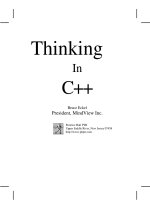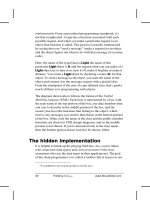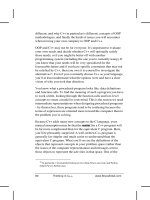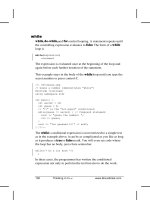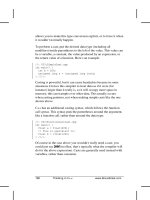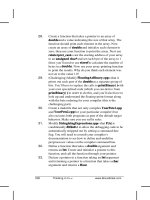Thinking in C plus plu (P3) doc
Bạn đang xem bản rút gọn của tài liệu. Xem và tải ngay bản đầy đủ của tài liệu tại đây (167.55 KB, 50 trang )
80 Thinking in C++ www.BruceEckel.com
different, and why C++ in particular is different, concepts of OOP
methodologies, and finally the kinds of issues you will encounter
when moving your own company to OOP and C++.
OOP and C++ may not be for everyone. It’s important to evaluate
your own needs and decide whether C++ will optimally satisfy
those needs, or if you might be better off with another
programming system (including the one you’re currently using). If
you know that your needs will be very specialized for the
foreseeable future and if you have specific constraints that may not
be satisfied by C++, then you owe it to yourself to investigate the
alternatives
21
. Even if you eventually choose C++ as your language,
you’ll at least understand what the options were and have a clear
vision of why you took that direction.
You know what a procedural program looks like: data definitions
and function calls. To find the meaning of such a program you have
to work a little, looking through the function calls and low-level
concepts to create a model in your mind. This is the reason we need
intermediate representations when designing procedural programs
– by themselves, these programs tend to be confusing because the
terms of expression are oriented more toward the computer than to
the problem you’re solving.
Because C++ adds many new concepts to the C language, your
natural assumption may be that the
main( )
in a C++ program will
be far more complicated than for the equivalent C program. Here,
you’ll be pleasantly surprised: A well-written C++ program is
generally far simpler and much easier to understand than the
equivalent C program. What you’ll see are the definitions of the
objects that represent concepts in your problem space (rather than
the issues of the computer representation) and messages sent to
those objects to represent the activities in that space. One of the
21
In particular, I recommend looking at Java () and Python
().
1: Introduction to Objects 81
delights of object-oriented programming is that, with a well-
designed program, it’s easy to understand the code by reading it.
Usually there’s a lot less code, as well, because many of your
problems will be solved by reusing existing library code.
83
2: Making & Using Objects
This chapter will introduce enough C++ syntax and
program construction concepts to allow you to write
and run some simple object-oriented programs. In the
subsequent chapter we will cover the basic syntax of C
and C++ in detail.
84 Thinking in C++ www.BruceEckel.com
By reading this chapter first, you’ll get the basic flavor of what it is
like to program with objects in C++, and you’ll also discover some
of the reasons for the enthusiasm surrounding this language. This
should be enough to carry you through Chapter 3, which can be a
bit exhausting since it contains most of the details of the C
language.
The user-defined data type, or
class
, is what distinguishes C++ from
traditional procedural languages. A class is a new data type that
you or someone else creates to solve a particular kind of problem.
Once a class is created, anyone can use it without knowing the
specifics of how it works, or even how classes are built. This
chapter treats classes as if they are just another built-in data type
available for use in programs.
Classes that someone else has created are typically packaged into a
library. This chapter uses several of the class libraries that come
with all C++ implementations. An especially important standard
library is iostreams, which (among other things) allow you to read
from files and the keyboard, and to write to files and the display.
You’ll also see the very handy
string
class, and the
vector
container
from the Standard C++ Library. By the end of the chapter, you’ll
see how easy it is to use a pre-defined library of classes.
In order to create your first program you must understand the tools
used to build applications.
The process of language translation
All computer languages are translated from something that tends
to be easy for a human to understand (
source code
)
into something
that is executed on a computer (
machine instructions
). Traditionally,
translators fall into two classes:
interpreters
and
compilers
.
2: Making & Using Objects 85
Interpreters
An interpreter translates source code into activities (which may
comprise groups of machine instructions) and immediately
executes those activities. BASIC, for example, has been a popular
interpreted language. Traditional BASIC interpreters translate and
execute one line at a time, and then forget that the line has been
translated. This makes them slow, since they must re-translate any
repeated code. BASIC has also been compiled, for speed. More
modern interpreters, such as those for the Python language,
translate the entire program into an intermediate language that is
then executed by a much faster interpreter
1
.
Interpreters have many advantages. The transition from writing
code to executing code is almost immediate, and the source code is
always available so the interpreter can be much more specific when
an error occurs. The benefits often cited for interpreters are ease of
interaction and rapid development (but not necessarily execution)
of programs.
Interpreted languages often have severe limitations when building
large projects (Python seems to be an exception to this). The
interpreter (or a reduced version) must always be in memory to
execute the code, and even the fastest interpreter may introduce
unacceptable speed restrictions. Most interpreters require that the
complete source code be brought into the interpreter all at once.
Not only does this introduce a space limitation, it can also cause
more difficult bugs if the language doesn’t provide facilities to
localize the effect of different pieces of code.
1
The boundary between compilers and interpreters can tend to become a bit fuzzy,
especially with Python, which has many of the features and power of a compiled
language but the quick turnaround of an interpreted language.
86 Thinking in C++ www.BruceEckel.com
Compilers
A compiler translates source code directly into assembly language
or machine instructions. The eventual end product is a file or files
containing machine code. This is an involved process, and usually
takes several steps. The transition from writing code to executing
code is significantly longer with a compiler.
Depending on the acumen of the compiler writer, programs
generated by a compiler tend to require much less space to run, and
they run much more quickly. Although size and speed are
probably the most often cited reasons for using a compiler, in many
situations they aren’t the most important reasons. Some languages
(such as C) are designed to allow pieces of a program to be
compiled independently. These pieces are eventually combined
into a final
executable
program by a tool called the
linker
. This
process is called
separate compilation
.
Separate compilation has many benefits. A program that, taken all
at once, would exceed the limits of the compiler or the compiling
environment can be compiled in pieces. Programs can be built and
tested one piece at a time. Once a piece is working, it can be saved
and treated as a building block. Collections of tested and working
pieces can be combined into
libraries
for use by other programmers.
As each piece is created, the complexity of the other pieces is
hidden. All these features support the creation of large programs
2
.
Compiler debugging features have improved significantly over
time. Early compilers only generated machine code, and the
programmer inserted print statements to see what was going on.
This is not always effective. Modern compilers can insert
information about the source code into the executable program.
This information is used by powerful
source-level debuggers
to show
2
Python is again an exception, since it also provides separate compilation.
2: Making & Using Objects 87
exactly what is happening in a program by tracing its progress
through the source code.
Some compilers tackle the compilation-speed problem by
performing
in-memory compilation
. Most compilers work with files,
reading and writing them in each step of the compilation process.
In-memory compilers keep the compiler program in RAM. For
small programs, this can seem as responsive as an interpreter.
The compilation process
To program in C and C++, you need to understand the steps and
tools in the compilation process. Some languages (C and C++, in
particular) start compilation by running a
preprocessor
on the source
code. The preprocessor is a simple program that replaces patterns
in the source code with other patterns the programmer has defined
(using
preprocessor directives
). Preprocessor directives are used to
save typing and to increase the readability of the code. (Later in the
book, you’ll learn how the design of C++ is meant to discourage
much of the use of the preprocessor, since it can cause subtle bugs.)
The pre-processed code is often written to an intermediate file.
Compilers usually do their work in two passes. The first pass
parses
the pre-processed code. The compiler breaks the source code into
small units and organizes it into a structure called a
tree
. In the
expression “
A + B
” the elements ‘
A
’, ‘
+,
’ and ‘
B
’ are leaves on the
parse tree.
A
global optimizer
is sometimes used between the first and second
passes to produce smaller, faster code.
In the second pass, the
code generator
walks through the parse tree
and generates either assembly language code or machine code for
the nodes of the tree. If the code generator creates assembly code,
the assembler must then be run. The end result in both cases is an
object module (a file that typically has an extension of
.o
or
.obj
). A
peephole optimizer
is sometimes used in the second pass to look for
88 Thinking in C++ www.BruceEckel.com
pieces of code containing redundant assembly-language
statements.
The use of the word “object” to describe chunks of machine code is
an unfortunate artifact. The word came into use before object-
oriented programming was in general use. “Object” is used in the
same sense as “goal” when discussing compilation, while in object-
oriented programming it means “a thing with boundaries.”
The
linker
combines a list of object modules into an executable
program that can be loaded and run by the operating system. When
a function in one object module makes a reference to a function or
variable in another object module, the linker resolves these
references; it makes sure that all the external functions and data
you claimed existed during compilation do exist. The linker also
adds a special object module to perform start-up activities.
The linker can search through special files called
libraries
in order to
resolve all its references. A library contains a collection of object
modules in a single file. A library is created and maintained by a
program called a
librarian
.
Static type checking
The compiler performs
type checking
during the first pass. Type
checking tests for the proper use of arguments in functions and
prevents many kinds of programming errors. Since type checking
occurs during compilation instead of when the program is running,
it is called
static type checking
.
Some object-oriented languages (notably Java) perform some type
checking at runtime (
dynamic type checking
). If combined with static
type checking, dynamic type checking is more powerful than static
type checking alone. However, it also adds overhead to program
execution.
C++ uses static type checking because the language cannot assume
any particular runtime support for bad operations. Static type
2: Making & Using Objects 89
checking notifies the programmer about misuses of types during
compilation, and thus maximizes execution speed. As you learn
C++, you will see that most of the language design decisions favor
the same kind of high-speed, production-oriented programming
the C language is famous for.
You can disable static type checking in C++. You can also do your
own dynamic type checking – you just need to write the code.
Tools for separate compilation
Separate compilation is particularly important when building large
projects. In C and C++, a program can be created in small,
manageable, independently tested pieces. The most fundamental
tool for breaking a program up into pieces is the ability to create
named subroutines or subprograms. In C and C++, a subprogram
is called a
function
, and functions are the pieces of code that can be
placed in different files, enabling separate compilation. Put another
way, the function is the atomic unit of code, since you cannot have
part of a function in one file and another part in a different file; the
entire function must be placed in a single file (although files can
and do contain more than one function).
When you call a function, you typically pass it some
arguments
,
which are values you’d like the function to work with during its
execution. When the function is finished, you typically get back a
return value
, a value that the function hands back to you as a result.
It’s also possible to write functions that take no arguments and
return no values.
To create a program with multiple files, functions in one file must
access functions and data in other files. When compiling a file, the
C or C++ compiler must know about the functions and data in the
other files, in particular their names and proper usage. The
compiler ensures that functions and data are used correctly. This
process of “telling the compiler” the names of external functions
90 Thinking in C++ www.BruceEckel.com
and data and what they should look like is called
declaration
. Once
you declare a function or variable, the compiler knows how to
check to make sure it is used properly.
Declarations vs. definitions
It’s important to understand the difference between
declarations
and
definitions
because these terms will be used precisely throughout
the book. Essentially all C and C++ programs require declarations.
Before you can write your first program, you need to understand
the proper way to write a declaration.
A
declaration
introduces a name – an identifier – to the compiler. It
tells the compiler “This function or this variable exists somewhere,
and here is what it should look like.” A
definition
, on the other
hand, says: “Make this variable here” or “Make this function here.”
It allocates storage for the name. This meaning works whether
you’re talking about a variable or a function; in either case, at the
point of definition the compiler allocates storage. For a variable, the
compiler determines how big that variable is and causes space to be
generated in memory to hold the data for that variable. For a
function, the compiler generates code, which ends up occupying
storage in memory.
You can declare a variable or a function in many different places,
but there must be only one definition in C and C++ (this is
sometimes called the ODR:
one-definition rule
). When the linker is
uniting all the object modules, it will usually complain if it finds
more than one definition for the same function or variable.
A definition can also be a declaration. If the compiler hasn’t seen
the name
x
before and you define
int x;
, the compiler sees the name
as a declaration and allocates storage for it all at once.
Function declaration syntax
A function declaration in C and C++ gives the function name, the
argument types passed to the function, and the return value of the
2: Making & Using Objects 91
function. For example, here is a declaration for a function called
func1( )
that takes two integer arguments (integers are denoted in
C/C++ with the keyword
int
) and returns an integer:
int func1(int,int);
The first keyword you see is the return value all by itself:
int
. The
arguments are enclosed in parentheses after the function name in
the order they are used. The semicolon indicates the end of a
statement; in this case, it tells the compiler “that’s all – there is no
function definition here!”
C and C++ declarations attempt to mimic the form of the item’s
use. For example, if
a
is another integer the above function might
be used this way:
a = func1(2,3);
Since
func1
( ) returns an integer, the C or C++ compiler will check
the use of
func1( )
to make sure that
a
can accept the return value
and that the arguments are appropriate.
Arguments in function declarations may have names. The compiler
ignores the names but they can be helpful as mnemonic devices for
the user. For example, we can declare
func1( )
in a different fashion
that has the same meaning:
int func1(int length, int width);
A gotcha
There is a significant difference between C and C++ for functions
with empty argument lists. In C, the declaration:
int func2();
means “a function with any number and type of argument.” This
prevents type-checking, so in C++ it means “a function with no
arguments.”
92 Thinking in C++ www.BruceEckel.com
Function definitions
Function definitions look like function declarations except that they
have bodies. A body is a collection of statements enclosed in braces.
Braces denote the beginning and ending of a block of code. To give
func1( )
a definition that is an empty body (a body containing no
code), write:
int func1(int length, int width) { }
Notice that in the function definition, the braces replace the
semicolon. Since braces surround a statement or group of
statements, you don’t need a semicolon. Notice also that the
arguments in the function definition must have names if you want
to use the arguments in the function body (since they are never
used here, they are optional).
Variable declaration syntax
The meaning attributed to the phrase “variable declaration” has
historically been confusing and contradictory, and it’s important
that you understand the correct definition so you can read code
properly. A variable declaration tells the compiler what a variable
looks like. It says, “I know you haven’t seen this name before, but I
promise it exists someplace, and it’s a variable of X type.”
In a function declaration, you give a type (the return value), the
function name, the argument list, and a semicolon. That’s enough
for the compiler to figure out that it’s a declaration and what the
function should look like. By inference, a variable declaration might
be a type followed by a name. For example:
int a;
could declare the variable
a
as an integer, using the logic above.
Here’s the conflict: there is enough information in the code above
for the compiler to create space for an integer called
a
, and that’s
what happens. To resolve this dilemma, a keyword was necessary
for C and C++ to say “This is only a declaration; it’s defined
2: Making & Using Objects 93
elsewhere.” The keyword is
extern
. It can mean the definition is
extern
al to the file, or that the definition occurs later in the file.
Declaring a variable without defining it means using the
extern
keyword before a description of the variable, like this:
extern int a;
extern
can also apply to function declarations. For
func1( )
, it looks
like this:
extern int func1(int length, int width);
This statement is equivalent to the previous
func1( )
declarations.
Since there is no function body, the compiler must treat it as a
function declaration rather than a function definition. The
extern
keyword is thus superfluous and optional for function declarations.
It is probably unfortunate that the designers of C did not require
the use of
extern
for function declarations; it would have been more
consistent and less confusing (but would have required more
typing, which probably explains the decision).
Here are some more examples of declarations:
//: C02:Declare.cpp
// Declaration & definition examples
extern int i; // Declaration without definition
extern float f(float); // Function declaration
float b; // Declaration & definition
float f(float a) { // Definition
return a + 1.0;
}
int i; // Definition
int h(int x) { // Declaration & definition
return x + 1;
}
int main() {
b = 1.0;
94 Thinking in C++ www.BruceEckel.com
i = 2;
f(b);
h(i);
} ///:~
In the function declarations, the argument identifiers are optional.
In the definitions, they are required (the identifiers are required
only in C, not C++).
Including headers
Most libraries contain significant numbers of functions and
variables. To save work and ensure consistency when making the
external declarations for these items, C and C++ use a device called
the
header file
. A header file is a file containing the external
declarations for a library; it conventionally has a file name
extension of ‘h’, such as
headerfile.h
. (You may also see some older
code using different extensions, such as
.hxx
or
.hpp
, but this is
becoming rare.)
The programmer who creates the library provides the header file.
To declare the functions and external variables in the library, the
user simply includes the header file. To include a header file, use
the
#include
preprocessor directive. This tells the preprocessor to
open the named header file and insert its contents where the
#include
statement appears. A
#include
may name a file in two
ways: in angle brackets (
< >
) or in double quotes.
File names in angle brackets, such as:
#include <header>
cause the preprocessor to search for the file in a way that is
particular to your implementation, but typically there’s some kind
of “include search path” that you specify in your environment or
on the compiler command line. The mechanism for setting the
search path varies between machines, operating systems, and C++
implementations, and may require some investigation on your part.
File names in double quotes, such as:
2: Making & Using Objects 95
#include "local.h"
tell the preprocessor to search for the file in (according to the
specification) an “implementation-defined way.” What this
typically means is to search for the file relative to the current
directory. If the file is not found, then the include directive is
reprocessed as if it had angle brackets instead of quotes.
To include the iostream header file, you write:
#include <iostream>
The preprocessor will find the iostream header file (often in a
subdirectory called “include”) and insert it.
Standard C++ include format
As C++ evolved, different compiler vendors chose different
extensions for file names. In addition, various operating systems
have different restrictions on file names, in particular on name
length. These issues caused source code portability problems. To
smooth over these rough edges, the standard uses a format that
allows file names longer than the notorious eight characters and
eliminates the extension. For example, instead of the old style of
including
iostream.h
, which looks like this:
#include <iostream.h>
you can now write:
#include <iostream>
The translator can implement the include statements in a way that
suits the needs of that particular compiler and operating system, if
necessary truncating the name and adding an extension. Of course,
you can also copy the headers given you by your compiler vendor
to ones without extensions if you want to use this style before a
vendor has provided support for it.
96 Thinking in C++ www.BruceEckel.com
The libraries that have been inherited from C are still available with
the traditional ‘
.h
’ extension. However, you can also use them with
the more modern C++ include style by prepending a “
c
” before the
name. Thus:
#include <stdio.h>
#include <stdlib.h>
become:
#include <cstdio>
#include <cstdlib>
And so on, for all the Standard C headers. This provides a nice
distinction to the reader indicating when you’re using C versus
C++ libraries.
The effect of the new include format is not identical to the old:
using the
.h
gives you the older, non-template version, and
omitting the
.h
gives you the new templatized version. You’ll
usually have problems if you try to intermix the two forms in a
single program.
Linking
The linker collects object modules (which often use file name
extensions like
.o
or
.obj
), generated by the compiler, into an
executable program the operating system can load and run. It is the
last phase of the compilation process.
Linker characteristics vary from system to system. In general, you
just tell the linker the names of the object modules and libraries you
want linked together, and the name of the executable, and it goes to
work. Some systems require you to invoke the linker yourself. With
most C++ packages you invoke the linker through the C++
compiler. In many situations, the linker is invoked for you
invisibly.
2: Making & Using Objects 97
Some older linkers won’t search object files and libraries more than
once, and they search through the list you give them from left to
right. This means that the order of object files and libraries can be
important. If you have a mysterious problem that doesn’t show up
until link time, one possibility is the order in which the files are
given to the linker.
Using libraries
Now that you know the basic terminology, you can understand
how to use a library. To use a library:
1. Include the library’s header file.
2. Use the functions and variables in the library.
3. Link the library into the executable program.
These steps also apply when the object modules aren’t combined
into a library. Including a header file and linking the object
modules are the basic steps for separate compilation in both C and
C++.
How the linker searches a library
When you make an external reference to a function or variable in C
or C++, the linker, upon encountering this reference, can do one of
two things. If it has not already encountered the definition for the
function or variable, it adds the identifier to its list of “unresolved
references.” If the linker has already encountered the definition, the
reference is resolved.
If the linker cannot find the definition in the list of object modules,
it searches the libraries. Libraries have some sort of indexing so the
linker doesn’t need to look through all the object modules in the
library – it just looks in the index. When the linker finds a definition
in a library, the entire object module, not just the function
definition, is linked into the executable program. Note that the
whole library isn’t linked, just the object module in the library that
98 Thinking in C++ www.BruceEckel.com
contains the definition you want (otherwise programs would be
unnecessarily large). If you want to minimize executable program
size, you might consider putting a single function in each source
code file when you build your own libraries. This requires more
editing
3
, but it can be helpful to the user.
Because the linker searches files in the order you give them, you
can pre-empt the use of a library function by inserting a file with
your own function, using the same function name, into the list
before the library name appears. Since the linker will resolve any
references to this function by using your function before it searches
the library, your function is used instead of the library function.
Note that this can also be a bug, and the kind of thing C++
namespaces prevent.
Secret additions
When a C or C++ executable program is created, certain items are
secretly linked in. One of these is the startup module, which
contains initialization routines that must be run any time a C or
C++ program begins to execute. These routines set up the stack and
initialize certain variables in the program.
The linker always searches the standard library for the compiled
versions of any “standard” functions called in the program.
Because the standard library is always searched, you can use
anything in that library by simply including the appropriate header
file in your program; you don’t have to tell it to search the standard
library. The iostream functions, for example, are in the Standard
C++ library. To use them, you just include the
<iostream>
header
file.
If you are using an add-on library, you must explicitly add the
library name to the list of files handed to the linker.
3
I would recommend using Perl or Python to automate this task as part of your
library-packaging process (see www.Perl.org or www.Python.org).
2: Making & Using Objects 99
Using plain C libraries
Just because you are writing code in C++, you are not prevented
from using C library functions. In fact, the entire C library is
included by default into Standard C++. There has been a
tremendous amount of work done for you in these functions, so
they can save you a lot of time.
This book will use Standard C++ (and thus also Standard C) library
functions when convenient, but only
standard
library functions will
be used, to ensure the portability of programs. In the few cases in
which library functions must be used that are not in the C++
standard, all attempts will be made to use POSIX-compliant
functions. POSIX is a standard based on a Unix standardization
effort that includes functions that go beyond the scope of the C++
library. You can generally expect to find POSIX functions on Unix
(in particular, Linux) platforms, and often under DOS/Windows.
For example, if you’re using multithreading you are better off using
the POSIX thread library because your code will then be easier to
understand, port and maintain (and the POSIX thread library will
usually just use the underlying thread facilities of the operating
system, if these are provided).
Your first C++ program
You now know almost enough of the basics to create and compile a
program. The program will use the Standard C++ iostream classes.
These read from and write to files and “standard” input and output
(which normally comes from and goes to the console, but may be
redirected to files or devices). In this simple program, a stream
object will be used to print a message on the screen.
Using the iostreams class
To declare the functions and external data in the iostreams class,
include the header file with the statement
#include <iostream>
100 Thinking in C++ www.BruceEckel.com
The first program uses the concept of standard output, which
means “a general-purpose place to send output.” You will see other
examples using standard output in different ways, but here it will
just go to the console. The iostream package automatically defines a
variable (an object) called
cout
that accepts all data bound for
standard output.
To send data to standard output, you use the operator
<<
. C
programmers know this operator as the “bitwise left shift,” which
will be described in the next chapter. Suffice it to say that a bitwise
left shift has nothing to do with output. However, C++ allows
operators to be
overloaded
. When you overload an operator, you
give it a new meaning when that operator is used with an object of
a particular type. With iostream objects, the operator
<<
means
“send to.” For example:
cout << "howdy!";
sends the string “howdy!” to the object called
cout
(which is short
for “console output”).
That’s enough operator overloading to get you started. Chapter 12
covers operator overloading in detail.
Namespaces
As mentioned in Chapter 1, one of the problems encountered in the
C language is that you “run out of names” for functions and
identifiers when your programs reach a certain size. Of course, you
don’t really run out of names; it does, however, become harder to
think of new ones after awhile. More importantly, when a program
reaches a certain size it’s typically broken up into pieces, each of
which is built and maintained by a different person or group. Since
C effectively has a single arena where all the identifier and function
names live, this means that all the developers must be careful not to
accidentally use the same names in situations where they can
2: Making & Using Objects 101
conflict. This rapidly becomes tedious, time-wasting, and,
ultimately, expensive.
Standard C++ has a mechanism to prevent this collision: the
namespace
keyword. Each set of C++ definitions in a library or
program is “wrapped” in a namespace, and if some other definition
has an identical name, but is in a different namespace, then there is
no collision.
Namespaces are a convenient and helpful tool, but their presence
means that you must be aware of them before you can write any
programs. If you simply include a header file and use some
functions or objects from that header, you’ll probably get strange-
sounding errors when you try to compile the program, to the effect
that the compiler cannot find any of the declarations for the items
that you just included in the header file! After you see this message
a few times you’ll become familiar with its meaning (which is “You
included the header file but all the declarations are within a
namespace and you didn’t tell the compiler that you wanted to use
the declarations in that namespace”).
There’s a keyword that allows you to say “I want to use the
declarations and/or definitions in this namespace.” This keyword,
appropriately enough, is
using
. All of the Standard C++ libraries
are wrapped in a single namespace, which is
std
(for “standard”).
As this book uses the standard libraries almost exclusively, you’ll
see the following
using directive
in almost every program:
using namespace std;
This means that you want to expose all the elements from the
namespace called
std
. After this statement, you don’t have to worry
that your particular library component is inside a namespace, since
the
using
directive makes that namespace available throughout the
file where the
using
directive was written.
102 Thinking in C++ www.BruceEckel.com
Exposing all the elements from a namespace after someone has
gone to the trouble to hide them may seem a bit counterproductive,
and in fact you should be careful about thoughtlessly doing this (as
you’ll learn later in the book). However, the
using
directive
exposes only those names for the current file, so it is not quite as
drastic as it first sounds. (But think twice about doing it in a header
file – that
is
reckless.)
There’s a relationship between namespaces and the way header
files are included. Before the modern header file inclusion was
standardized (without the trailing ‘
.h
’, as in
<iostream>
), the
typical way to include a header file was with the ‘
.h
’, such as
<iostream.h>
. At that time, namespaces were not part of the
language either. So to provide backward compatibility with
existing code, if you say
#include <iostream.h>
it means
#include <iostream>
using namespace std;
However, in this book the standard include format will be used
(without the ‘
.h
’) and so the
using
directive must be explicit.
For now, that’s all you need to know about namespaces, but in
Chapter 10 the subject is covered much more thoroughly.
Fundamentals of program structure
A C or C++ program is a collection of variables, function
definitions, and function calls. When the program starts, it executes
initialization code and calls a special function, “
main( )
.” You put
the primary code for the program here.
As mentioned earlier, a function definition consists of a return type
(which must be specified in C++), a function name, an argument
2: Making & Using Objects 103
list in parentheses, and the function code contained in braces. Here
is a sample function definition:
int function() {
// Function code here (this is a comment)
}
The function above has an empty argument list and a body that
contains only a comment.
There can be many sets of braces within a function definition, but
there must always be at least one set surrounding the function
body. Since
main( )
is a function, it must follow these rules. In C++,
main( )
always has return type of
int
.
C and C++ are free form languages. With few exceptions, the
compiler ignores newlines and white space, so it must have some
way to determine the end of a statement. Statements are delimited
by semicolons.
C comments start with
/*
and end with
*/
. They can include
newlines. C++ uses C-style comments and has an additional type of
comment:
//
. The
//
starts a comment that terminates with a
newline. It is more convenient than
/* */
for one-line comments, and
is used extensively in this book.
"Hello, world!"
And now, finally, the first program:
//: C02:Hello.cpp
// Saying Hello with C++
#include <iostream> // Stream declarations
using namespace std;
int main() {
cout << "Hello, World! I am "
<< 8 << " Today!" << endl;
} ///:~
104 Thinking in C++ www.BruceEckel.com
The
cout
object is handed a series of arguments via the ‘
<<
’
operators. It prints out these arguments in left-to-right order. The
special iostream function
endl
outputs the line and a newline. With
iostreams, you can string together a series of arguments like this,
which makes the class easy to use.
In C, text inside double quotes is traditionally called a “string.”
However, the Standard C++ library has a powerful class called
string
for manipulating text, and so I shall use the more precise
term
character array
for text inside double quotes.
The compiler creates storage for character arrays and stores the
ASCII equivalent for each character in this storage. The compiler
automatically terminates this array of characters with an extra piece
of storage containing the value 0 to indicate the end of the character
array.
Inside a character array, you can insert special characters by using
escape sequences
. These consist of a backslash (
\
) followed by a
special code. For example
\n
means newline. Your compiler
manual or local C guide gives a complete set of escape sequences;
others include
\t
(tab),
\\
(backslash), and
\b
(backspace).
Notice that the statement can continue over multiple lines, and that
the entire statement terminates with a semicolon
Character array arguments and constant numbers are mixed
together in the above
cout
statement. Because the operator
<<
is
overloaded with a variety of meanings when used with
cout
, you
can send
cout
a variety of different arguments and it will “figure
out what to do with the message.”
Throughout this book you’ll notice that the first line of each file will
be a comment that starts with the characters that start a comment
(typically
//
), followed by a colon, and the last line of the listing will
end with a comment followed by ‘
/:~
’. This is a technique I use to
allow easy extraction of information from code files (the program
